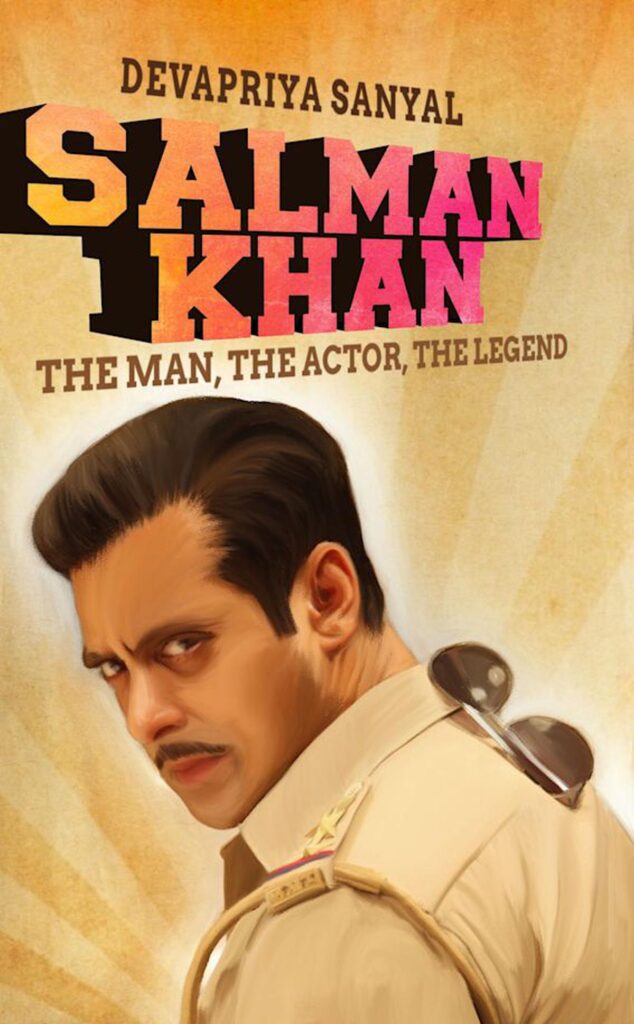Mumbai, MAHARASHTRA :
Steering clear of the actor’s controversial life, a new biography focuses on India’s notion of stardom and celebrity instead

A recent bout of illness and feeling all round wretched had me turning to my favourite comfort food — Hindi movies (I refuse to call them Bollywood movies) from the 1990s. That I was simultaneously reading Devapriya Sanyal’s Salman Khan The Man The Actor The Legend, a deconstruction of bhai’s celebrity, proved an adequate road map to my film choices…
Rather than start with Salman Khan’s big, fat blockbuster, Maine Pyaar Kiya (1989), I chose Hum Aapke Hain Koun..! (1994), also directed by Sooraj Barjatya (who had made his directorial debut with Maine Pyaar Kiya). The film, which cemented Khan as a bonafide star, actually gave his co-star, Madhuri Dixit, higher billing, a fact which Sanyal’s book mentions.
Hum Aapke Hain Koun..! unlike that other game-changer of the ‘90s, Dilwale Dulhania Le Jayenge (1995), has not aged well, Dixit’s phulkari-inspired jacket notwithstanding. The film plays out like a loosely strung together series of incidents, songs and comic interludes. How is a dog playing an umpire at a cricket match supposed to be funny is one of those unsolved mysteries. And while we are on the topic, hope Tuffy, the dog, was treated right on set.
Defence of toxicity
Sanyal’s book mostly steers clear of all the scandals and controversies that followed Khan like faithful shadows. While there is mention of the 2002 hit-and-run case, his tumultuous relationship with Aishwarya Rai and its fallout, and the blackbuck hunting and Arms Act violations cases, the book focuses on decoding Khan and India’s notion of stardom and celebrity through his career.
What little we glimpse of Khan is through his good friend Kailash Surendranath’s reminiscences. Surendranath, who knew Khan from his days as an eager 15-year-old getting his first break in modelling for Campa Cola (remember?) to his decade-spanning superstardom, remembers Khan dropping by for late night paratha-bhurji (scrambled eggs) and his motto for working on his body — “When you have no work, work on yourself.”
An introduction sets out what Sanyal intends to do through the book in great detail. The shortest chapter is the one called ‘With Human Failings’, which lists Khan’s headline-grabbing misbehaviour. His public brawls and brushes with the law are explained away as the cost of celebrity, which does not cut much ice as one cannot sweep bad and outright criminal behaviour under the carpet of “boys will be boys”. The book is at its weakest when trying to defend Khan’s toxicity.
An engaging journey
On the other hand, Sanyal’s book is its most engaging when deconstructing Khan through his roles especially in the chapter, ‘The Journey from Prem to Chulbul Pandey’. The chapter introduces the concept of the Emploi, “a theoretical framework as developed by Erving Goffman in his book, Frame Analysis.” The emploi, Sanyal posits “is a category that accounts for the close interaction between performance and reception.”
Just as Amitabh Bachchan’s angry young man was invariably called Vijay (is his Jai in Sholay a diminutive for Vijay?) and Shah Rukh Khan’s many versions of Dilwale Dulhania Le Jayenge’s Raj went towards building an on-screen persona, so too does Salman’s Prem emploi create a film version of Salman Khan.
Sanyal traces Khan’s development through his 15 different portrayals of Prem. From the slender, doe-eyed Prem of Maine Pyar Kiya, the naughty ‘devar’ Prem in Hum Aapke Hain Koun..!, the Prem who sets things right in Hum Saath-Saath Hain (1999) and the slightly dim-witted Prem of Andaz Apna Apna (1994), who nevertheless gets the girl to the tongue-in-cheek narrator Prem of Ready (2011), the cheating-on-his wife Prem of No Entry (2005), the dating guru Prem of Partner (2007) and the travelling theatre artiste Prem of Prem Ratan Dhan Payo (2015), in his fourth collaboration with Barjatya.
Since the chapter details Khan’s journey from Prem to Chulbul Pandey, there is an analysis of the characters he played who are not named Prem, including Akash in that slightly cringy but melodious triangle Saajan (1991), Sameer in Sanjay Leela Bhansali’s exotically colourful Hum Dil De Chuke Sanam (1999), the obsessed lover, Radhe Mohan in Tere Naam (2003), the tapori Radhe in Wanted (2009), Devil in Kick (2014), Bajrangi in Bajrangi Bhaijaan (2015) and Tiger in Ek Tha Tiger (2012) and Tiger Zinda Hai (2017), Laxman in Tubelight (2017) Sultan in and as Sultan (2021), and of course the corrupt but loveable cop Chulbul Pandey in the Dabangg movies.
Sanyal, who teaches English literature at the University of Delhi, has written a thesis on the anatomy of fame with academic rigour— right down to how Khan’s perfect body also contributes to his iconography. Wish the book was better proofed as there are silly errors that grate coming on the back of such a well-researched book.
All looking for salacious details of Khan’s life will be disappointed while those seeking the magic in the bottle of stardom will not. And I am going back to watching Khan fight off the evil Crime Master Gogo in the delightful Andaz Apna Apna.
Salman Khan The Man The Actor The Legend; Devapriya Sanyal, Bloomsbury, ₹699.
mini.chhibber@thehindu.co.in
source: http://www.thehindu.com/ The Hindu / Home> Books> Review / by Mini Anthikad Chhibber / July 22nd, 2022








